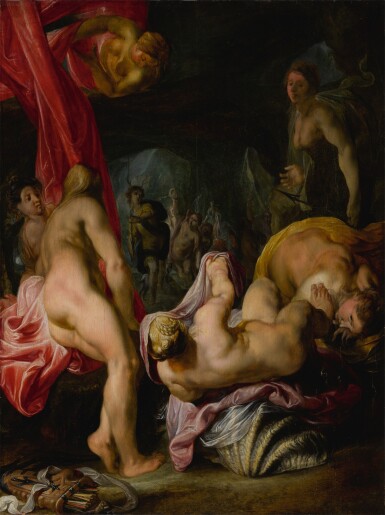Master Paintings
Master Paintings

A Life of John Richardson: A Scholar Collects
Antwerp School, circa 1615/1620, possibly the young Jacob Jordaens
Diana and Actaeon
Auction Closed
May 20, 03:42 PM GMT
Estimate
25,000 - 35,000 USD
Lot Details
Description
A Life of John Richardson: A Scholar Collects
Antwerp School, circa 1615/1620, possibly the young Jacob Jordaens
Diana and Actaeon
inscribed on labels on the reverse: Ralph Papé and Villa d'Este/Haseltine
oil on oak panel
panel: 25 ⅜ by 19 ⅛ in.; 64.4 by 48.6 cm.
framed: 46 ¾ by 41 in.; 118.7 by 104.1 cm.
Thence by descent;
Anonymous sale ("Property from a Private Collection"), London, Sotheby's, 5 July 2012, lot 236 (as Antwerp School, second decade of the 17th century).
J. Rowlands, "'Johann Liss' at Augsburg", in The Burlington Magazine, vol. CXVII, no. 873, 1975, pp. 832 and 835 (where an attribution to the young Liss is discussed);
R. Spear, "Johann Liss Reconsidered", in The Art Bulletin, vol. 58, 1976, p. 585, reproduced p. 584, fig. 2 (expressing serious reservations about the painting's attribution to Liss);
R. Klessman, Johann Liss. A Monograph and Catalogue Raisonné, Ghent 1999, p. 193 (as 'Unknown Flemish master'; under Selection of Works Incorrectly Attributed to Liss).
This scene teems with energy, color, and the figural form. It was painted in Antwerp around 1615-1620 by a very accomplished hand. Initially, an attribution to the young Johann Liss was put forward by Sir Denis Mahon, when he first saw the painting in 1973. He suggested Liss may have painted it not long after his arrival in Antwerp from Holland and before his departure for Italy. This attribution was later endorsed by others including Benedict Nicolson and Erich Schleier, although Dr. Rüdiger Klessman published it under the group of wrongly attributed works in his 1999 monograph on the artist.
The sheer dynamic quality of the composition, however, suggests a virtuosic hand. The connection to both Rubens and Jordaens in the sensual depiction of nudes is undeniable in this work, and, in fact, an attribution to the young Jacob Jordaens has more recently been proposed. Indeed, the attention paid to the beauty of the human form, with the flesh tones of the figures serving as pleasing contrasts to the opulent elements surrounding them, enlivens the packed and dynamic scene in a manner in keeping with the style of the young Jordaens. Some parallels can be drawn between the present work and a fragment by Jordaens of Moses striking water from the rock of circa 1615.1 Both compositions are slightly imbalanced and the figural types of both are modeled in a similar fashion. Additionally, the somewhat complicated and agitated poses of the figures in the present work have some resemblance to those found in Jordaens' Lapiths and Centaurs, also of circa 1615, in a private collection.2
According to the catalogue entry the last time this painting appeared at auction in 2012, technical examinations, including infra-red reflectography, completed on the panel in about 1995 revealed some underdrawing, particularly in the head of the nymph in the right foreground: two attempts at her profile were drawn, neither of which were followed in the final painting.
This composition was engraved in reverse by Jacob Coelemans in 1700 as after Otto van Veen.3
1. https://rkd.nl/explore/images/193058
2. https://rkd.nl/explore/images/8110
3. https://www.britishmuseum.org/collection/object/P_1855-0609-734
